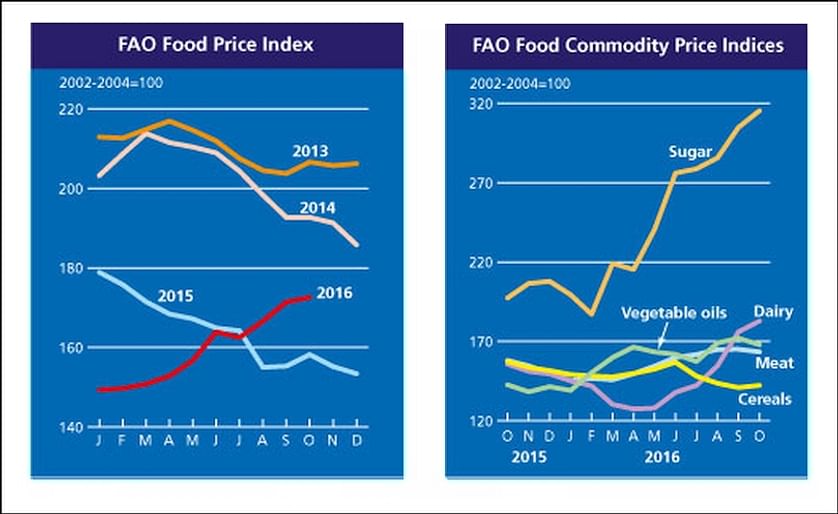In October 2016, the FAO Food Price Index averaged 172.6 points in October 2016, up 1.2 points (0.7 percent) from September and 9.1 percent above the corresponding month last year. Except for a short-lived drop in July, the Index has risen continuously since the start of the year.
Global Food Prices keep going up

The FAO Food Price Index (FFPI) averaged 172.6 points in October 2016, up 1.2 points (0.7 percent) from September and 9.1 percent above the corresponding month last year.
Except for a short-lived drop in July, the Index has risen continuously since the start of the year.
In October, sugar and dairy values rose sharply, while the cereal index made a modest increase.
These gains coincided with sharp declines in the oils and meat indices, which kept the overall value of the FFPI only slightly above its September average.
The FAO Cereal Price Index averaged 142.3 points in October, up 1.4 points (1.0 percent) from September and 9.6 percent below the previous year’s level. The rise in October marked the first month-on-month increase after three months of decline. Although crop harvest and weak buying interest continued to weigh on rice quotations, wheat prices were up, largely driven by tightening supplies of high quality wheat, while maize quotations also increased mainly because of an accelerated pace of sales by the United States.
The FAO Oils/Fats Price Index averaged nearly 168 points in October, down 4 points (or 2.4 percent) from September but still well above its year-earlier level. The month-on-month drop, which follows two months of increase, was primarily driven by palm oil. International palm oil quotations weakened as production improvements in Southeast Asia coincided with sluggish global import demand, prompting stock increases, especially in Malaysia. The drop in the index in October was, however, capped by firm soy, sunflower and rapeseed oil values.
The FAO Dairy Price Index averaged 182.8 points in October, up 6.8 points (3.9 percent) from September. Quotations rose for all dairy products, in particular butter which was bolstered by reduced stocks and sustained internal demand in the EU, combined with a rise in buying interest by importing countries. Cheese prices also strengthened, while milk powders recorded more modest increases. Falling month-on-month milk production in the EU and lower output in Oceania have raised expectations of a likely forthcoming tightening in export supplies and fuelled a price surge in recent months.
The FAO Meat Price Index averaged 163.4 points in October, down 1.7 points (1 percent) from its revised value for September. A decline in EU export prices for pigmeat, stemming from excess domestic supplies and a slackening in import demand from China, was the principal cause of the Index's decline. Additionally, Oceania bovine meat export prices continued to decrease, as increased domestic production in the United States obviated its need for external supplies. Conversely, Oceania ovine meat prices reached their highest level in almost two years, due to reduced output in both Australia and New Zealand.
The FAO Sugar price index averaged 315.3 points in October, up 10.5 points (3.4 percent) from September, the sixth consecutive monthly increase. The latest gain in international sugar prices was largely on the back of reports of a lower than expected harvest in the Centre South main producing region in Brazil, the world’s largest sugar producer and exporter, as drier than normal weather affected sugarcane production. Reports of a production shortfall in India, the world’s second largest sugar producer, namely in the top-producing state of Maharashtra, which will require imports by the country to meet demand also helped to lift sugar prices.
Except for a short-lived drop in July, the Index has risen continuously since the start of the year.
In October, sugar and dairy values rose sharply, while the cereal index made a modest increase.
These gains coincided with sharp declines in the oils and meat indices, which kept the overall value of the FFPI only slightly above its September average.
The FAO Cereal Price Index averaged 142.3 points in October, up 1.4 points (1.0 percent) from September and 9.6 percent below the previous year’s level. The rise in October marked the first month-on-month increase after three months of decline. Although crop harvest and weak buying interest continued to weigh on rice quotations, wheat prices were up, largely driven by tightening supplies of high quality wheat, while maize quotations also increased mainly because of an accelerated pace of sales by the United States.
The FAO Oils/Fats Price Index averaged nearly 168 points in October, down 4 points (or 2.4 percent) from September but still well above its year-earlier level. The month-on-month drop, which follows two months of increase, was primarily driven by palm oil. International palm oil quotations weakened as production improvements in Southeast Asia coincided with sluggish global import demand, prompting stock increases, especially in Malaysia. The drop in the index in October was, however, capped by firm soy, sunflower and rapeseed oil values.
The FAO Dairy Price Index averaged 182.8 points in October, up 6.8 points (3.9 percent) from September. Quotations rose for all dairy products, in particular butter which was bolstered by reduced stocks and sustained internal demand in the EU, combined with a rise in buying interest by importing countries. Cheese prices also strengthened, while milk powders recorded more modest increases. Falling month-on-month milk production in the EU and lower output in Oceania have raised expectations of a likely forthcoming tightening in export supplies and fuelled a price surge in recent months.
The FAO Meat Price Index averaged 163.4 points in October, down 1.7 points (1 percent) from its revised value for September. A decline in EU export prices for pigmeat, stemming from excess domestic supplies and a slackening in import demand from China, was the principal cause of the Index's decline. Additionally, Oceania bovine meat export prices continued to decrease, as increased domestic production in the United States obviated its need for external supplies. Conversely, Oceania ovine meat prices reached their highest level in almost two years, due to reduced output in both Australia and New Zealand.
The FAO Sugar price index averaged 315.3 points in October, up 10.5 points (3.4 percent) from September, the sixth consecutive monthly increase. The latest gain in international sugar prices was largely on the back of reports of a lower than expected harvest in the Centre South main producing region in Brazil, the world’s largest sugar producer and exporter, as drier than normal weather affected sugarcane production. Reports of a production shortfall in India, the world’s second largest sugar producer, namely in the top-producing state of Maharashtra, which will require imports by the country to meet demand also helped to lift sugar prices.
Source
Food and Agriculture Organization of the United Nations (FAO)





